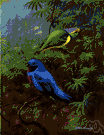cotinga
(redirected from cotingas)Also found in: Thesaurus, Encyclopedia.
cotinga
(kəˈtɪŋɡə)n
(Animals) any tropical American passerine bird of the family Cotingidae, such as the umbrella bird and the cock-of-the-rock, having a broad slightly hooked bill. Also called: chatterer
Collins English Dictionary – Complete and Unabridged, 12th Edition 2014 © HarperCollins Publishers 1991, 1994, 1998, 2000, 2003, 2006, 2007, 2009, 2011, 2014
co•tin•ga
(koʊˈtɪŋ gə, kə-)n.
any of numerous suboscine birds comprising the family Cotingidae, of New World tropical forests: diverse in size and habits, with many species having spectacular plumage and far-carrying voices.
[1775–85; < New Latin < French < Tupi]
Random House Kernerman Webster's College Dictionary, © 2010 K Dictionaries Ltd. Copyright 2005, 1997, 1991 by Random House, Inc. All rights reserved.
ThesaurusAntonymsRelated WordsSynonymsLegend:
Switch to new thesaurus
| Noun | 1. |  cotinga - passerine bird of New World tropics cotinga - passerine bird of New World tropicsNew World flycatcher, tyrant bird, tyrant flycatcher, flycatcher - large American birds that characteristically catch insects on the wing genus Cotinga - type genus of the Cotingidae: cotingas Rupicola rupicola, cock of the rock - tropical bird of northern South America the male having brilliant red or orange plumage and an erectile disklike crest cock of the rock, Rupicola peruviana - bird of the Andes similar to Rupicola rupicola bellbird - any of several tropical American birds of the genus Procnias having a bell-like call Cephalopterus ornatus, umbrella bird - black tropical American bird having a large overhanging crest and long feathered wattle |
Based on WordNet 3.0, Farlex clipart collection. © 2003-2012 Princeton University, Farlex Inc.